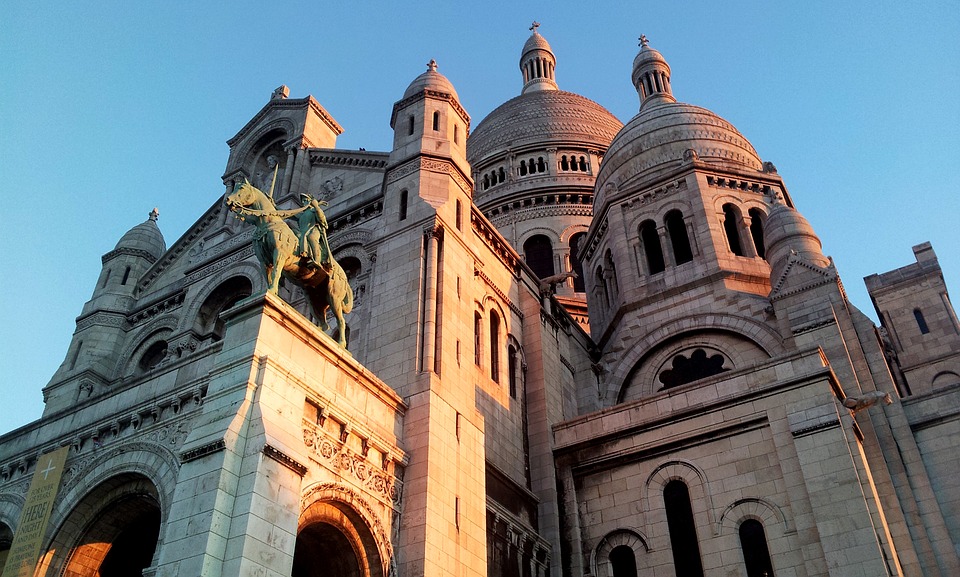A Trip to Paris: Visiting the French Capital’s Most Famous Attractions (Part 4) Posted by mtaulier on Nov 11, 2013 in Uncategorized
In the last few installments, we discovered La Tour Eiffel, L’Arc de Triomphe, Notre-Dame de Paris and Le Musée du Louvre. Today, we will be ascending a long flight of stairs to make our way to another famous tourist attraction just north of downtown Paris: La Basilique du Sacré-Cœur de Montmartre (The Basilica of the Sacred-Heart of Monmartre).

This Roman Catholic basilica offers the most stunning view of Paris. Thanks to its location sur la colline de Montmartre (atop Montmartre hill), at its highest peak the basilica is even taller than the Eiffel Tower. It is also unique because of its color. Les pierres blanches (the white stones), called Château-Landon stones, secrete calcite, a mineral that bleaches the stone when it rains and thus allows the church to maintain its stark white appearance as it ages. Coincidentally, Montmartre became famous as the area where many artists chose to live and work. Pablo Picasso, Vincent Van Gogh, Claude Monet and others had studios in the area. But today we will be focusing on the religious history of Montmartre and its basilica with its long and storied history.
The hill of Montmartre was used as a site religieux (religious site) in the centuries before Christ. Originally a place of worship pour les Druides Gaulois (for Gallic Druids), the hill became home to Roman temples dédiés aux dieux Mars et Mercure (dedicated to the gods Mars and Mercury). A chapel was built in the 5th century, followed by l’Eglise Saint-Pierre (Saint-Peter’s Church) and an abbey built by King Louis VI in the 12th century. It remained so until the end of the 19th century when the basilica was finally erected. The name Montmartre is short for Mont des Martyrs (Martyr’s Mountains) to commemorate the martyrdom of Saint Denis, le premier évêque de Paris (the first bishop of Paris) who was beheaded during the Decian persecutions in the 3rd century. Ever since, Montmartre has become an important lieu de pèlerinage (place of pilgrimage) for Christian pilgrims from all over the world.
The basilica was erected as a public display of penitence following the Franco-Prussian War of 1870-71. Having suffered defeat at the hands of the Germans, the French believed they should do penance by building a basilica dedicated to the Sacred Heart of Christ. Un concours (A contest) was held to choose the architect and in 1873, Paul Abadie was selected as le gagnant (the winner) and began laying plans to build the basilica in the Roman-Byzantine style as opposed to the French tradition of building in the Romanesque style. The first stone was laid in 1875 but he died in 1884. Several architects took over his work and the basilica was consecrated in 1919.
There is no visite guidée (guided visit) of the basilica or the crypt, only visite libre (free/open visit) and admission is free. If you wish to visit the dome, it will cost a few euros but nothing prohibitive. Remember that the view from the top of the basilica (over 400 meters high) is higher than it is from the Eiffel Tower so it might be worth your while. Take time to appreciate la plus grande mosaïque de France (France’s largest mosaic) made by Luc-Olivier Merson entitled Christ in Majesty, and of course don’t forget to admire the massive pipe organ rivaling that of Notre-Dame.
If you don’t have time to visit both Notre-Dame and the Eiffel Tower, le Sacré-Cœur might prove a worthy substitute. You’ll be able to visit one of the world’s most beautiful basilicas and enjoy a terrific view of Paris at the same time. Le Sacré-Cœur is France’s version of St. Peter’s basilica in Rome and if you want the complete Parisian experience, it should not be missed.

Build vocabulary, practice pronunciation, and more with Transparent Language Online. Available anytime, anywhere, on any device.




Comments:
Alfred Johnson:
Amazing and informative article on A Trip to Paris. The photography are inviting and interesting.